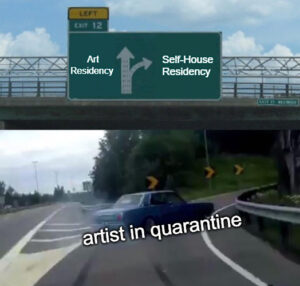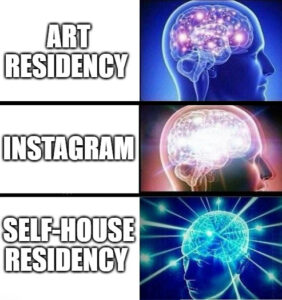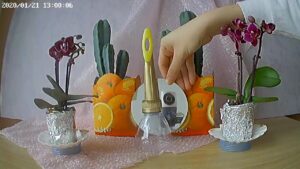 Katie Zazenski from Warsaw
Katie Zazenski from Warsaw
By the second week of March 2020, systems across the US began grinding to a halt, ushering in the great online migration. Much of the rest of the affected world had already begun this process, provoked by the coronavirus pandemic, which, alarming health concerns aside, has produced waves of logistical confusion and panic as we near-blindly face this novel frontier collectively. Within the art community we have been asking: how do we survive a gig economy with no gigs? How do we continue to make and show art, how do we teach the nuance and physicality to our students without physical proximity to either materials or each other? Like many others, I’ve been in a disoriented haze, blindly scrolling Instagram and Facebook, confined to my apartment for all but essential movement, sufficiently socially-distanced and trying to suss out some remainder of focus as the world as we know it somewhat briskly implodes. Faced with varying levels of quarantine, for the first time in too long we’re experiencing 24/7 direct contact with our dark corners and need to source strength and hope from wherever it is that we can. Dutch artist Eva Van Ooijen agrees. Van Ooijen has been interested in the intersection of faith-based rituals and the internet for some time, but it wasn’t until last summer that she made her first cyberpilgrimage to a home altar. Before Covid-19 meant anything to anyone, Van Ooijen, feeling anxious about leaving her home for an upcoming trip, set up her first shrine—a few candles set into hand-squished aluminum foil holders, some oranges, a plastic bottle with water, a paper juice carton, draped bubble wrap— in front of a baby monitor, so that she could remain connected while away. Being able to check-in via phone soothed her sense of untetheredness and replaced it with a very palpable sense of connectedness.
The first radio sermons were broadcast about a century ago, the first image was uploaded to the internet in 1992. Fundamental aspects of life develop remote arms the moment technology makes it possible, extending outreach, obscuring geographical constraints, bypassing all sorts of obstacles and impediments unavoidable in the embodied world. While creating or viewing art or even making a pilgrimage online might not be groundbreaking, the criticality of such acts shifts dramatically in times of global stress, especially when we often find solace in things that are not new but rather familiar and known—no matter how faint the resemblance may be. I found Van Ooijen’s work on the Digital Artist Residency platform during one of my quarantine-inspired Instagram spirals. The Digital Artist Residency, created by Tom Milnes in 2015, is an internet-based platform which hosts artists for typically month-long, you guessed it, digital residencies. Since creating the DAR, Milnes has witnessed a shift in how internet-based works and platforms are received by brick-and-mortar institutions, noting new-found recognition of digitally-native works and platforms as legitimate cultural output in a way that didn’t much exist only a handful of years ago. Milnes is optimistic, seeing this current epoch as one filled with possibility, as an opportunity to really change the way we think about online spaces— not simply as parallels or stand-ins for physical reality but rather entirely new, unconfined spaces that don’t play by the same biological or physical rules that we so often and unnecessarily apply.
Van Ooijen also recognizes the promise of this moment, and offers what little she can during such disorienting times. She is interested in hope; her work speaks to belief in miracles, in the supernatural, and the capacity of individually constructed realities to motivate transformation. She is interested in ‘traveling’ and experiencing the world via the internet, and the power of such expanded notions of what constitutes a ‘real’ experience. She has made a slightly modified version of her digital shrine available on YouTube. Within the first two minutes, the camera settles a bit, we hear a child as well as the artist’s voice, a hand comes into the frame to set and light a candle. Otherwise, the only movement throughout the hour-and-a-half clip comes from the flicker of the candle flame and the shifting sunlight, an occasional shadow from a human form passing between the light source and the altar. She gives us an opportunity to be still, to be connected without contact. Van Ooijen will happily light a candle for you, all you have to do is ask.
What is involved here aside from resilience is a considerable amount of aspiration, trust, and of course, faith. In conversation with Van Ooijen, we kept circling back to this blurring and blending of digital and physical space, and how the notion of healing doesn’t perhaps require the physical proximity to totems in the ways that we once might have been led to believe. Healing, transformation, it comes from within.
How do we perform rituals—both digitally and not—and is this perhaps unique for each experience? What are the objects and talismans that we carry with us, physically and spiritually? Can we make and show artwork in the physical world to live and breathe online? What are the losses, what are the gains, what negotiations are made between these realms? It is becoming increasingly critical to contemplate these types of questions because the truth is, this time is not a stand-in. It is the budding of a new reality. And while wildly unprecedented and unsettling, it’s important to keep in mind that this is not entirely a bad thing, that this territory is not completely uncharted, and that it is, in fact, laden with possibility.
Within these prospects of course there is some concern. One aspect of this for Milnes, who has spent considerable time shaping internet space, is that this time will produce a glut of poorly thought-out projects and digital relocations instead of a call to invent new ways of existence. While people and institutions scramble to maintain some semblance of normality, to preserve relevancy, to somehow re-perform physical reality and the hierarchies that such a theoretically democratic/decentralized space as the internet doesn’t inherently perform (Google rankings and algorithms/tiered access is not inherent to the network structure), many are trying to simply migrate their events and replicate their normal systems online instead of acknowledging that the internet is not a duplicate of physical space but rather a gravity-less, rhizomatic network without linear time or geographic place. Łukasz Horbów and Magdalena Morawik of Self House Residency, an Instagram-based platform developed in response to the current pandemic, note another concern which warrants consideration, that the perception of architecture changes during self-isolation as we are performing public rituals in private and private rituals in this newly exposed, collective realm. This time of social distancing, of quarantine and lockdown will undoubtedly have a profound effect on our concept of proximity and space—architecturally, psychologically, and physiologically.
So how do we ease the transition? How do we account for shifting boundaries, the psychological affirmations that physical structure inspires? What happens to our value systems for art, art production, and art education? What happens to the art market? What about the biennales, the art fairs? David Quiles Guilló, creator of The Wrong, has been exploring much of this since 2013 and offers yet another example of not only how this can work, but how there is truly limitless potential here. The Wrong was conceptually initiated on Thursday, February 21, 2013 as the world’s first international, digital art biennial. As a contract to himself, guaranteeing accountability by making the declaration via Facebook, Quiles Guilló set out to organize a three-month long art biennale from his home. His goal from the beginning has been to support digital culture by engaging with a vast selection of curated artworks, embracing the artists, curators, and institutions of the global digital culture scene, with a focus on gathering and nurturing. The Wrong has since evolved into a platform featuring a daily feed, a program of online exhibitions, print publications, a TV platform (an 24/7 free live-stream dedicated to digital art, music & culture) and has engaged and created a space for thousands of artists and cultural producers to share work, exchange ideas, and explore a less-bounded space.
 For Van Ooijen, the physical shrine provides comfort—she notes the scale: the tactility of materials, the weight of the objects are a knowable scope while the internet in contrast is so massive, so incomprehensible in both its structure and scope. For her, the most critical aspect of these shrines is that they can be shared and live online, in a more public realm. It’s an attempt to reach people, to provide access when there otherwise wouldn’t be—whether it’s due to a public health crisis or an economic, social, or geographical blockade. At the end of the day, these journeys are about an individual transformational experience, so why shouldn’t we be able to take a cyber pilgrimage to Lourdes, or Graceland, or the Guggenheim? We are learning how to rethink our rituals, redefine our needs and edges and capabilities. These are the practices that will carry us through and into this new aeon, armed with sanitizer and a strong wireless signal, we can be anywhere, do anything, and see anyone—we can incite our own revolution from the confines of whatever physicality we occupy.
For Van Ooijen, the physical shrine provides comfort—she notes the scale: the tactility of materials, the weight of the objects are a knowable scope while the internet in contrast is so massive, so incomprehensible in both its structure and scope. For her, the most critical aspect of these shrines is that they can be shared and live online, in a more public realm. It’s an attempt to reach people, to provide access when there otherwise wouldn’t be—whether it’s due to a public health crisis or an economic, social, or geographical blockade. At the end of the day, these journeys are about an individual transformational experience, so why shouldn’t we be able to take a cyber pilgrimage to Lourdes, or Graceland, or the Guggenheim? We are learning how to rethink our rituals, redefine our needs and edges and capabilities. These are the practices that will carry us through and into this new aeon, armed with sanitizer and a strong wireless signal, we can be anywhere, do anything, and see anyone—we can incite our own revolution from the confines of whatever physicality we occupy.
As Hito Steyerl notes in her essay ‘In Free Fall: A Thought Experiment on Vertical Perspective’, we, as a global society, have been under constant renegotiation of space and perspective. Perhaps this reorientation to the digital is not as difficult as we might think, it might just be happening at a speed we hadn’t prepared ourselves for just yet. As our conventional systems crumble, new rhizomatic networks arise. Within the art world, communities have reflexively sprung-up to provide support and alternatives for the professors who are now forced to teach sculpture online, for the thesis-shows that will now only be produced and witnessed via weblink, for the practicing artists with projects and exhibitions, years in the making, suspended indefinitely. Emergency grants are slowly being doled out, platforms are being built. We are all fumbling through these hours trying not to lose time and momentum while having no idea what the future will hold, so right now generosity, faith, and 4G go a long way, ample time for reflection is required. It is our duty to consciously maneuver through the increased mutability and limitless potential for how to organize time, space, and connection. It is essential to recognize that the rules and patterns are different but not entirely unknown. It’s the time to sit in front of some altar, somewhere, to light a candle for one other, to mourn the loss of the world as we know it, and let these rituals give us the comfort and faith to know that while it’s hard, it’s not the end. It’s the time to dream again, to build the worlds that couldn’t possibly exist in the soils of this earth.
Eva Van Ooijen https://evavanooijen.nl/
Digital Artist Residency https://digitalartistresidency.org/
Self House Residency https://www.instagram.com/self_house_residency/
The Wrong https://thewrong.org/
volume 34 no 5 May / June 2020
